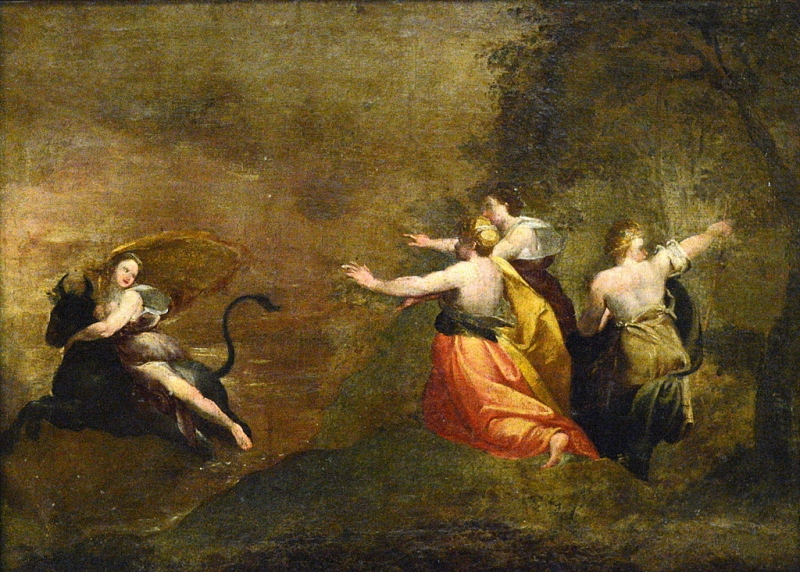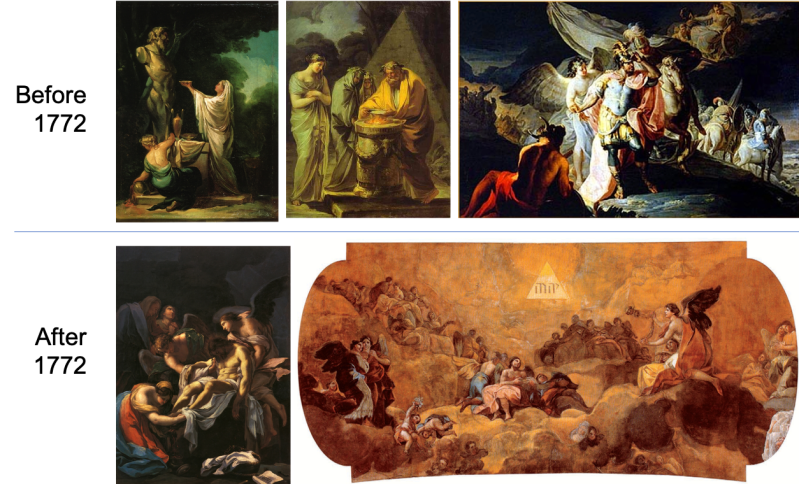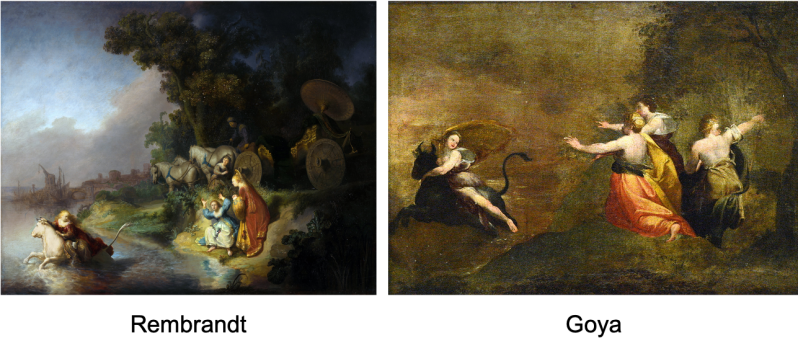Some artists stand outside of art movements, collectives, or schools, no matter how much art historians want to pigeonhole them into a group. And when everything else fails these artists get labelled “Romantic”. Aren’t we all when we’re young?
In 1772, when he painted this small-size work, Goya was 26, fresh from his Italian trip, and single.

This painting stands out because it is nowhere near Goya’s style at the time. In Italy, he was doing something in-between the Baroque and as yet non-existent Neo-Classicism, and when he came back from Italy, he got trapped in the design of Rococo tapestries.

The Bull is black, not white, not gracious, not licking Europa’s toes or hands, and quite intent on getting the hell out of the picture. Just like in Rembrandt’s work, the Bull is headed in the “wrong” direction: right-to-left instead of the “natural” left-to-right. Goya purged from his picture all unimportant details, leaving one maid shouting for help, and the other two helplessly stretching their hands towards the Princess they wouldn’t see ever again. I believe you remember that young Rembrandt (23), when he was painting this myth, also chose the point of no return in the plot: Europa is scared to fall off, the maids can’t swim as fast as the Bull, they see each other one last time – and then it is a very different life for all of them. Rembrandt was working on a hymn to the international trade, so he had to stuff his painting with gold, exotic carriages and the industrialised port. That improved intended message delivery but lessened the emotional impact of the painting. Young Goya packed a lot more feeling and desperation into the same pivotal moment.

Rembrandt positions the viewer as an uninvolved passer-by, equally distanced from all the parties. Goya makes the viewers a part of the story because Europa disappears from them too. Europa and the Bull are a split second away from running over the left border, and whoever decides to help won’t have enough time to get to the shoreline before it happens.
And, of course, Joseph Mallord Turner.

Turner couldn’t have seen Goya’s Europa, and I don’t remember reading of Turner seeing any late works of the Spaniard – what I know is that great minds think alike, across time and distance.
I also find it amusing that Turner is classified as an artist of the Romanticism movement. Imagine a fine foggy morning in Chelsea. Turner, in his usual bad-tempered disposition, leaves the house of his widow mistress. “Hello, Admiral”, shouts a neighbour at his back and Turner doesn’t turn his head, but acknowledges the greeting with in his grumpy voice. And then suddenly he walks into John Ruskin who smiles ear to ear excitedly, “Good morning, Mr Romanic Painter!” I think I can picture Turner’s rage in my mind.
In case you missed the previous chapters:
Part I – In Antiquity, the age of discovery and adventure, the myth of Europa was a prologue to more exciting stories. Europa was not a victim, just a participant in the grand scheme of things.
Part II – Late Middle Ages and the Renaissance: Search for emotions in the plot and a new meaning of the story. Durer vs Titian. Artists discovered that high-level emotions can be combined with violence and eroticism. First signs of women’s empowerment in art with Europa’s making the Bull do her bidding.
Quiz: Why Rubens copied Titian’s Rape differently to the original and what conjugal infidelity, Jesuits and Velazquez had to do with it
Part III – During the Catholic Baroque, Europa was seen as a saint or a prized whore, but Claude Lorrain made her into a device that allowed his clients to show off their enlightened character.
Part IV – Lutheran Baroque – How did the domestication of women during the Reformation relate to the myth of Europa? Why is Rembrandt’s Abduction of Europa a celebration of Protestant values?
Part V – The Rococo Europa didn’t mind exchanging her virginity for a queendom. How to spot a Rococo painting using my Rococo Style Bingo Card and why you should never take the Rococo seriously.

another place…
once my partner and I walking the Appalachian Mountain Trail, met a couple of armed youngsters. Not far-right. The mediocre right. Drunk as hell. No way to cross the street. Awkward. Strong opinions, lack of self-criticism and guns are always troublesome.
regards, Drager
Strong opinions in this case are very much equal to semi-religious fanaticism, and in a combination with alcohol and weapons it can easily become a deadly mix…
Turner indeed, and not only in this work of Goya’s! You’ve hit the bull’s eye with this discovery (pun must have been subconsciously intended). I would add that this is a distinctly Spanish bull, imagine any corrida scene, they are all dark and smaller thand the blond variety of Northern parts. Oops, this came out a bit weird, but anyway… And there is a satanic air to him. It is like an evil ghost taking the maiden to the sinful unknown. This is Spain of the Inquisition after all…
You are right about the corrida – he painted a lot of them in the early 1800s )
And the Inquisition – it is an interesting period when a Spanish politician and write Olavide was prosecuted for reading and believing in the doctrines of the Encyclopedia. Something we find incomprehensible now…
It looks like Goya and Turner are working from the same pallet.
Leslie
Different pigments, same effect )